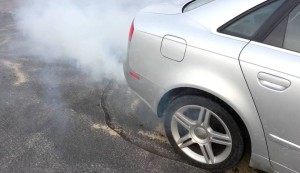Although some exhaust smoke is considered normal operation for many diesel engines, especially older units, the cause of excessive exhaust smoke should be diagnosed and repaired.
Black Smoke
Black exhaust smoke is caused by incomplete combustion because of a lack of air or a fault in the injection system that could cause an excessive amount of fuel in the cylinders. Items that should be checked include the following:
- Fuel specific gravity (API gravity)
- Injector balance test to locate faulty injectors using a scan tool
- Proper operation of the engine coolant temperature (ECT) sensor
- Proper operation of the fuel rail pressure (FRP) sensor
- Restrictions in the intake or turbocharger
- Engine oil usage
White Smoke
White exhaust smoke occurs most often during cold engine starts because the smoke is usually condensed fuel droplets. White exhaust smoke is also an indication of cylinder misfire on a warm engine. The most common causes of white exhaust smoke include:
- Inoperative glow plugs
- Low engine compression
- Incorrect injector spray pattern
- Coolant leak into the combustion chamber
Gray or Blue Smoke
Blue exhaust smoke is usually due to oil consumption caused by worn piston rings, scored cylinder walls, or defective valve stem seals. Gray or blue smoke can also be caused by a defective injector(s).
![ASE Certification Training HQ - Free ASE Practice Tests [Updated 2021]](https://asecertificationtraining.com/wp-content/themes/simplefolio/images/ASE Certification Logo.png)

